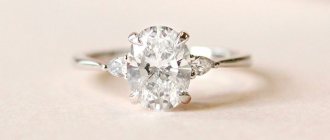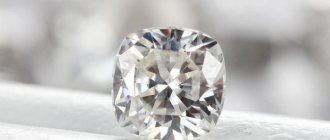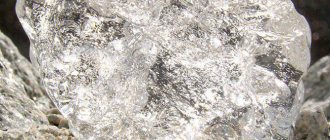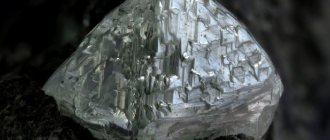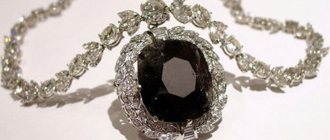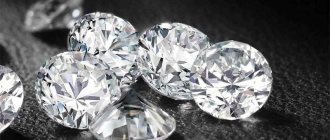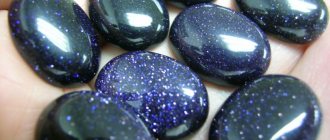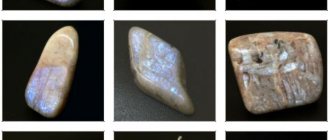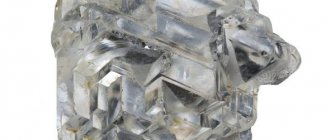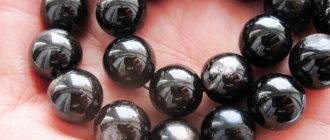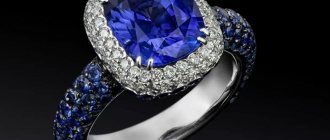Moissanite is a rare gem. The amount of this beautiful mineral with a diamond luster is negligible in nature. It can only be found in corundum deposits, kimberlite rock and some meteorites. And this is the main thing to remember when you see the word “moissanite” on a jewelry label - it will always not be a natural stone, but its artificially grown brother - carborundum or silicon carbide.
But in space there is quite a lot of real moissanite. It is found in dust clouds formed from carbon. And the study of the Murchison meteorite led scientists to the conclusion that the silicon carbide it contains was formed far beyond the solar system.
History and origin
The first attempts to synthesize silicon carbide in the laboratory were made in 1824 by the Swedish chemist Jens Jakob Berzelius. However, this was only achieved in 1892 by the American chemist Edward Acheson.
Edward Goodrich Acheson
Jons Jacob Berzelius
Having received the first crystalline sample of silicon carbide, he describes it for a patent, after which, a year later, he receives a patent and calls the future mineral carborundum.
Exhibit – Carborundum
In 1904, Ferdinand Frederic Henri Moissan, while examining samples of a meteorite found in Diablo Canyon (Arizona, USA), he discovered hexagonal plates of silicon carbide. This was the first discovery of the mineral in nature, after which it received its name - moissanite.
Synthetic moissanite
The mineral moissanite of jewelry and technical types is synthesized in the laboratory. Industrial-scale production has been established since 1987.
Five synthesis methods have been developed:
- sintering of silica with carbon;
- silicon carbide sublimation;
- from methane;
- heating in a graphite crucible;
- crystallization from a liquid state.
With any method, an artificial material of the required standards is obtained - jewelry or industrial.
Physico-chemical properties of stone
| Property | Description |
| Formula | SiC |
| Hardness | 8,5 — 9,5 |
| Refractive index | nω=2.654, nε=2.967, birefringence 0.313 (for 6H-SiC form) |
| Density (measured) | 3.218 - 3.22, average = 3.21 |
| singonia | Hexagonal |
| Kink | Conchoidal |
| Cleavage | Fuzzy by (0001) |
| Shine | Diamond to metallic |
| Transparency | Transparent |
| Color | Colorless, green, yellow, black |
Varieties and colors
According to modern classification, the mineral is divided into two types - natural (moissanite) and synthesized (carborundum):
- Natural, opaque stones are black and dark green in color, and their size is 0.5-4 mm.
- The artificial mineral can be presented in the form of 4-12 mm crystals, abrasive chips or powder.
In addition, scientists have learned to obtain such types of stone as:
- colorless, transparent imitation diamond;
- jewelry samples in blue, yellow, green, cognac and black shades;
- technical samples of purple, brown and other dark colors.
Where are moissanites found?
The main “deposit” of natural moissanites is meteorites that fell to Earth. But the grains extracted from there are no larger than 4 mm.
Moissanite single crystal ~1 mm in size
The stone is mined in kimberlite pipes, sometimes along with sapphire corundum. Rare, but found inside nugget diamonds.
Areas of application
Both natural and artificial stones have a great resemblance to a diamond, while a diamond is harder, less fire-resistant, and is slightly inferior in beauty to its counterpart. This is why moissanite is highly valued by jewelers and collectors.
In addition to jewelry, artificial stone is widely used in industry. With its help they make:
- abrasive tools;
- covering sections of body armor;
- composite armor;
- protection of devices from overvoltage;
- transistors;
- diodes, semiconductors, sealing parts;
- telescopic optics;
- heating elements;
- disc brakes;
- diesel filters.
In addition, it is a catalyst for the oxidation of hydrocarbons and is used for the synthesis of graphene and in nuclear energy.
Medicinal properties
According to lithotherapists, contemplation of a colorless, blue or light green stone promotes healing:
- diseases of the central and peripheral nervous system;
- stress, depression;
- somatic diseases;
- menopausal syndrome;
- psychiatric illnesses.
Reference! The mineral does not help with diseases with pathological changes in tissue, such as fractures, strokes, ulcers, atherosclerosis, etc.
Also, when contemplating the stone, attention, memory, and brain activity improve, nervous tension goes away, energy and vitality increase.
Magic properties
Talismans with moissanite attract good luck and help reveal the best character traits, while amulets and amulets protect against adversity. Any jewelry with natural/artificial stone has the same magical properties.
The stone itself helps to keep emotions under control, gives courage and strengthens the spirit, and supports in difficult life situations. It helps to overcome fear and self-doubt, develops the talent of eloquence, and does not allow any factors to influence the decisions of its owner. The stone can also improve your financial situation.
Interacting with all chakras, it purifies energy flows and human spirituality.
Reference! Both the stone itself and any products with it are suitable for magical effects. Natural moissanite does not need to be activated, but the synthesized mineral needs to be charged.
To do this, during the period when day and night last the same amount of time, the artificial stone must be left in direct sunlight. It is best to carry out the recharging procedure in the fresh air and in the morning, during dawn. The charging time of the stone is equal to the entire period until the sun rises.
Who is it suitable for?
Moissanite with an interesting play of light on its edges is considered one of the most noble and powerful jewelry minerals in the collection. The stone can shimmer in different shades in the sunlight, and at this time its impeccable inner beauty is emphasized.
Moissanite, which has deep character and unique characteristics, can be used as a talisman and amulet.
The jewelry mineral is suitable for the following people who have the following negative character traits:
- excessive desire to control circumstances;
- increased emotionality and sensitivity to the behavior of others who do not live up to expectations;
- having excessively high demands on oneself and the inability to relax.
Moissanite has strong energy, so special care is recommended when handling it. A jewelry mineral may be suitable immediately or never. Meditation will not help if you initially failed to establish contact.
Stone cost
Natural moissanite is a very rare and therefore expensive nugget. Synthesizing large stone crystals also makes them expensive.
However, the actual cost of the mineral will depend on its size, transparency and uniformity of color, color and the quality of the cut itself. Eg:
- a colorless artificial faceted stone of 1 carat (about 6.9 mm in diameter) will cost about $300;
- a green or blue stone of 1 carat is much cheaper - $240-250;
- 1 carat specimens in black, cognac or yellow - $220-230.
Of course, the cost of moissanite is lower than that of diamond, but small (up to 2 mm) stone chips will be more expensive than diamond chips of the same size.
Price
The price of each gemstone is determined by cut, color, clarity and weight. The most precious moissanites are very small and almost colorless. They are not often used for jewelry. In these cases, it is cheaper to use diamonds. Cheaper yellow and black stones.
Moissanite is characterized by the fact that its purity is almost always at the highest level . And its best shape is round. This mineral is very loved by Hollywood stars, and even some royalty. Because in its appearance, moissanite is almost impossible to distinguish from diamond.
Caring for your jewelry
Jewelry with moissanite should be stored in individual bags or cases. It is recommended to clean the product after each wear.
Jewelers clean jewelry using ultrasound, and at home you can remove cosmetics, grease and other organic dirt using dishwashing gel. Products are cleaned with a soft brush with gel, and then washed under running, slightly warm water. Afterwards, the jewelry is wiped with a soft cloth, dried with a hairdryer if necessary, and finally polished with a napkin.
Instead of gel, you can use an ammonia solution: mix cold clean water and ammonia in proportions of 3 to 1. Immerse the jewelry in the resulting solution for 10 minutes, then clean it with a brush, rinse with warm water, dry and polish.
Reference! Jewelry should be removed before going to the gym, jogging, or any other strenuous physical activity.
How to wear
Jewelry with moissanite is ideal for an evening or formal dress, classic and romantic style of clothing. At the same time, the stone should always be in sight. For example, if these are earrings with a stone, then the hairstyle should be high, revealing the lobes. It is better to combine dresses with open shoulders and a neckline with a necklace. There should be no sleeves with bracelets, but gloves with rings.
Pendant with stone
And under no circumstances should you combine moissanite with ornamental stones and other gems.
Jewelry with moissanite
As already mentioned, moissanite is a rare occurrence in nature, therefore only synthetic moissanite is used in jewelry.
The beauty of the stone, its easy care and affordable price make it a popular and favorite stone among fans of jewelry. Moissanite is truly superior to diamond in some ways. Colorless moissanite is more often used in jewelry, which creates the maximum resemblance to diamonds, although moissanite can be obtained in almost any color.
The best moissanites are supplied by the American company Charles & Colvard. These stones have a unique shine and clarity. Synthetic moissanites are produced in both Russia and China. But in quality they are somewhat inferior to American ones.
Rings
Since moissanite has high hardness, it is used for rings, and of large sizes. Perfect transparency, dazzling shine and sparkle delight buyers. And one more feature of moissanite is that during operation the stone does not change color and is not subject to mechanical damage. It will sparkle and delight you for many years.
Moissanite can add beauty to wedding and engagement rings. Since a luxurious gem has a cost many times lower than a diamond, many grooms on a limited budget can afford to buy such jewelry for their bride.
Earrings
Earrings with moissanite are a luxurious gift. Gold and silver are a wonderful setting for this stone. Earring pendants can be of various sizes, because moissanite is a synthetic stone, and therefore there will be no restrictions in size and shape.
Bracelets
Bracelets with moissanites will not leave anyone indifferent. We can say that the magnificence of such products “takes your breath away”. Here, just like in pendants, the size of the stones can be any.
Necklaces
Imagine that on your snow-white neck rests a necklace or necklace, the stones of which shimmer and sparkle not only in natural light, but also in artificial light. Of course, you will feel like a princess, because moissanites are almost diamonds. Only experienced specialists can distinguish their difference with the help of special instruments, and outwardly, hardly anyone dares to express doubts about the “diamonds” of your necklace.
Jewelry with moissanite is difficult for any girl to resist, especially if at the same time they declare their feelings, offering their hand and heart.
Caring for products with moissanite
. Moissanite requires simple care. To maintain freshness and cleanliness, it simply needs a warm soapy procedure.
Cost of products with moissanite
depends on size and cut. The larger the stone and the more luxurious the frame, the higher the price of the product. However, a synthetic stone is hundreds of times cheaper than a diamond. Products with moissanite can be worn by both men and women.
For this stone, it is not worth conducting research in the field of magical and medicinal properties; this is the lot only of natural stones. But this also has its advantages, because moissanite can then be worn by any of us without fear.
How to distinguish from a fake
Although moissanite is often used as an imitation of diamond, unscrupulous sellers sometimes deliberately hide this fact, passing off moissanite as a more expensive diamond.
Reference! A diamond is a well-cut diamond.
You can distinguish between a diamond and moissanite using an optical method using an X-ray, microscope or dichroscope. This method is the most reliable and safe for stones.
Among the differences between the stones are:
- hardness on the Mohs scale - diamond is harder;
- moissanite shines brighter:
- the color reflection of diamond is dominated by cold shades, while that of moissanite is dominated by iridescent shades;
- moissanite has no internal defects;
- moissanite absorbs UV rays, due to which it turns bright red-orange under ultraviolet light;
- When checked by x-ray, a diamond changes to green, yellow, blue or red.
In addition to optical methods, stones can also be distinguished by methods of compression, weighing, heating the surface with fire, electrical conductivity and Hodgkinson. However, these methods are used only by gemologists - firstly, this requires special equipment, and secondly, heat treatment and strength testing destroy the stones.
Reference! A diamond does not change color when heated, while moissanite begins to turn green over a flame.
Also, stones can be distinguished from each other by growth zones using a magnifying glass, microscope and lamp. Moissanite has more rounded growth lines, while diamond has zigzag curves or other unusual shapes.
Stones without a setting can be tested with water - an artificial moissanite will float, but a diamond will sink.
Difference from natural stone
Moissanite is considered the most perfect analogue of a diamond, which in its characteristics not only repeats, but also surpasses the natural prototype and has only small deviations that make it possible to distinguish it from a natural diamond. One of the main differences by which moissanite can be recognized lies in its external characteristics.
Everyone knows that the value of a diamond lies not only in its rarity and hardness, but also in its high refractive index of 2.418. The refractive index of moissanite is 25% higher. Therefore, a laboratory stone with the correct cut sparkles much brighter in the rays of light. A cut diamond from the depths of the earth also loses to a human-grown diamond in dispersion and sparks tens of times less.
For a long time it was not possible to obtain moissanite of a perfectly transparent color, and although in comparison with a diamond it does not have any foreign inclusions, its color has always been yellow. Several years ago this problem was solved and now natural diamonds also lose in the purity competition.
The structure of carbocorundum is very close to diamonds, so not every device can detect the differences between these twins.
Even experienced jewelers and specialists with extensive experience, in order to confidently talk about a diamond as natural, check stones according to several indicators at once, including: hardness, specific gravity, determination of reflection coefficient, electrical conductivity analysis and various optical tests.
Most often, the difference can be seen by visually comparing two stones with the same carat. Moissanite usually stands out and looks more sparkling and shiny. But this fact does not always make it possible to determine with 100% accuracy where the diamonds are and where they are not.
Compatibility with zodiac signs
(“+++” – the stone fits perfectly, “+” – can be worn, “-” – is strictly contraindicated):
| Zodiac sign | Compatibility |
| Aries | +++ |
| Taurus | + |
| Twins | +++ |
| Cancer | + |
| a lion | +++ |
| Virgo | + |
| Scales | +++ |
| Scorpion | + |
| Sagittarius | +++ |
| Capricorn | + |
| Aquarius | +++ |
| Fish | + |
Moissanite is most suitable for representatives of air or fire signs.
For Sagittarius, Aries, Gemini, Aquarius, Leo and Libra, the stone helps to establish the psycho-emotional sphere and also attracts finances.
It also helps Capricorns, Virgos, Taurus, Scorpios, Pisces and Cancers to acquire and protect material wealth.
